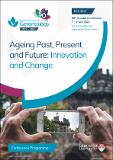| dc.contributor.author | White, P.J. | |
| dc.contributor.author | Patocs, Audrey | |
| dc.contributor.author | Raina, Parminder | |
| dc.date.accessioned | 2023-04-28T14:52:37Z | |
| dc.date.available | 2023-04-28T14:52:37Z | |
| dc.date.copyright | 2021 | |
| dc.date.issued | 2021-07-09 | |
| dc.identifier.citation | White, P. J., Patocs, A., & Raina, P. Harrington, L.(2021). Interdisciplinary Gerontological Research by Design. British Society of Gerontology 50th Annual Conference, Lancaster University. | en_US |
| dc.identifier.uri | https://research.thea.ie/handle/20.500.12065/4495 | |
| dc.description.abstract | Increasingly, gerontological research requires interdisciplinary approaches to address
complex research questions. Design methods have been proven to facilitate the growth of
interdisciplinary research as they are agile, adaptive, and iterative (White and Deevy, 2020).
Involving 140 researchers across 6 faculties, this study used design methods to create
interdisciplinary research on ageing. This paper discusses how Design methods were used to
successfully grow this research culture for over 5 years.
Low and high touch approaches to Design were used. A cross-campus environmental scan
was designed to understand cultural commonalities and differences between disciplines and
Design workshops were created to harness interdisciplinary understanding, encouraging
groups to create interdisciplinary proposals. Ethnographic research and surveys were
conducted to assess how Design methods had influenced research culture. Outputs and
partnerships were also assessed, and an international scientific committee reviewed
interdisciplinary research proposals.
Results showed that interdisciplinary partnerships and collaborations increased across
faculties. Positive changes in culture were observed, with increased interactions among
researchers. Scientific reviewers commented that proposals addressed needs, insured
stakeholders inclusion, and were likely to have a positive impact on older people. It
demonstrated that Design methods can assist in the creation of interdisciplinary
gerontological research. Design assisted researchers to find ‘common languages’ and was
beneficial in both group communication and proposal creation. Collaborating with other
disciplines offered researchers perspectives that were otherwise inaccessible and lead to more
inclusive research. | en_US |
| dc.format | application/pdf | en_US |
| dc.language.iso | eng | en_US |
| dc.publisher | British Society of Gerontology | en_US |
| dc.rights | Attribution 3.0 United States | * |
| dc.rights.uri | http://creativecommons.org/licenses/by/3.0/us/ | * |
| dc.subject | Older Adults | en_US |
| dc.subject | interdisiplinary research | en_US |
| dc.subject | design | en_US |
| dc.subject | design thinking | en_US |
| dc.title | Interdisciplinary gerontological research by design | en_US |
| dc.type | info:eu-repo/semantics/conferenceObject | en_US |
| dc.conference.date | 2021-07-09 | |
| dc.conference.location | Lancaster University | en_US |
| dc.contributor.affiliation | DesignCORE, Humanities, South East Technological University, Kilkenny Road, Carlow, Ireland | en_US |
| dc.contributor.affiliation | McMaster University, Canada | en_US |
| dc.description.peerreview | yes | en_US |
| dc.identifier.orcid | https://orcid.org/0000-0002-5716-8643 | en_US |
| dc.identifier.url | https://designchange.files.wordpress.com/2022/11/interdisciplinary-gerontological-research-by-design_june.pdf | en_US |
| dc.rights.accessrights | info:eu-repo/semantics/openAccess | en_US |
| dc.subject.department | DesignCORE | en_US |
| dc.type.version | info:eu-repo/semantics/publishedVersion | en_US |


